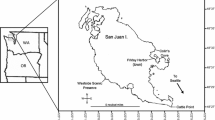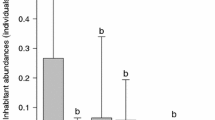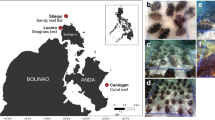Abstract
This paper concerns the effects on biodiversity of depletion of the South African abalone Haliotis midae, which is a long-lived species with a large corrugated shell that provides a habitat for diverse benthic organisms. We compared community structure on H. midae shells with that on adjacent rock at three sites (Cape Point and Danger Point sites A and B) and at two different times of the year at one of these sites. Shells of H. midae consistently supported communities that were distinctly different from those on rock. In particular, three species of non-geniculate (encrusting) corallines, Titanoderma polycephalum, Mesophyllum engelhartii and Spongites discoideus, were all found either exclusively or predominantly on shells, whereas another non-geniculate coralline, Heydrichia woelkerlingii, occurred almost exclusively on adjacent rock. The primary rocky substratum, however, supported a higher number of species than abalone shells. Possible reasons for the differences between the two substrata include the relative age, microtopography and hardness of the substrata; the abundance of grazers on them; and the relative age of different zones of the abalone shell, which support communities at different stages of succession. Diversity on shells was lowest in zones that were either very young or very old, in keeping with the intermediate disturbance hypothesis. The distinctiveness of shell epibiota will increase β diversity despite having a lower α diversity than that of adjacent rock. Decimation of H. midae by overfishing therefore has implications for biodiversity conservation.








Similar content being viewed by others
References
Alexander TJ, Barrett N, Haddon M, Edgar G (2009) Relationships between mobile macroinvertebrates and reef structure in a temperate marine reserve. Mar Ecol Prog Ser 389:31–44
Anderson MJ, Gorley RN, Clarke KR (2008) PERMANOVA for primer: guide to software and statistical methods. PRIMER-E Ltd, Plymouth, p 214
Ayres-Peres L, Mantelatto FL (2010) Epibiont occurrence on shells used by the hermit crab Loxopagurus loxochelis (Anomura: Diogenidae) on the northern coast of Sao Paulo, Brazil. Zoologia 27:222–227
Bell JJ (2005) Influence of occupant microhabitat on the composition of encrusting communities on gastropod shells. Mar Biol 147:653–661
Branch GM, Branch M (1981) The living shores of Southern Africa. Struik, Cape Town
Bruno JF, Bertness MD (2001) Habitat modification and facilitation in benthic marine communities. In: Bertness MD, Gaines SD, Hay ME (eds) Marine community ecology. Sinauer Associates, Sunderland, pp 201–218
Chalmers R (2002) An investigation into the feeding biology and factors influencing the population dynamics of Terebrasabella heterouncinata (Polychaeta: Sabellidae), a problematic tube-dwelling polychaete in farmed abalone in South Africa. MSc thesis, Rhodes University, South Africa
Clarke KR, Gorley RN (2006) Primer v6: user manual/tutorial. PRIMER-E Ltd, Plymouth, p 190
Connell JH (1978) Diversity in tropical rain forests and coral reefs. Science 199:1302–1310
Connell JH, Slatyer RO (1977) Mechanisms of succession in natural communities and their role in community stability and organization. Am Nat 111:1119–1144
Dean RL, Connell JH (1987) Marine invertebrates in an algal succession. III. Mechanisms linking habitat complexity with diversity. J Exp Mar Biol Ecol 109:249–273
Eager RC (2010) Documenting the association between a non-geniculate coralline red alga and its molluscan host. MSc thesis, University of the Western Cape, South Africa
Flint RW, Goldman CR (1975) The effects of a benthic grazer on the primary productivity of the littoral zone of Lake Tahoe. Limnol Oceanogr 20:935–944
Gee JM, Warwick RM (1994) Metazoan community structure in relation to the fractal dimensions of marine macroalgae. Mar Ecol Prog Ser 103:141–150
Gonzalez MJ, Downing A (1999) Mechanisms underlying amphipod responses to zebra mussel (Dreissena polymorpha) invasion and implications for fish-amphipod interactions. Can J Fish Aquat Sci 56:679–685
Hacker SD, Steneck RS (1990) Habitat architecture and the abundance and body-size-dependent habitat selection of a phytal amphipod. Ecology 71:2269–2285
Haigler SA (1969) Boring mechanism of Polydora websteri inhabiting Crassostrea virginica. Am Zool 9:821–828
Hargrave BT (1970) The effect of a deposit-feeding amphipod on the metabolism of benthic microflora. Limnol Oceanogr 15:21–30
Hauck M (2009) Crime, environment and power: revisiting the abalone fishery. S Afr J Crim Justice 22:229–245
Hauck M, Sweijd NA (1999) A case study of abalone poaching in South Africa and its impact on fisheries management. ICES J Mar Sci 56:1024–1032
Keats DW, Maneveldt G (1994) Leptophytum foveatum Chamberlain & Keats (Rhodophyta, Corallinales) retaliates against overgrowth by other encrusting algae. J Exp Mar Biol Ecol 175:243–251
Keats DW, Matthews I, Maneveldt G (1994) Preliminary studies on competitive relationships and coexistence in a guild of crustose algae in the eulittoral zone, Cape Province, South Africa. S Afr J Bot 60:108–113
Kraufvelin P, Salovius S, Christie H, Moy FE, Karez R, Pedersen MF (2006) Eutrophication-induced changes in benthic algae affect the behaviour and fitness of the marine amphipod Gammarus locusta. Aquat Bot 84:199–209
Lubchenco J, Menge BA (1978) Community development and persistence in a low rocky intertidal zone. Ecol Monogr 59:67–94
Maneveldt GW, Keats DW (2008) Effects of herbivore grazing on the physiognomy of the coralline alga Spongites yendoi and on associated competitive interactions. Afr J Mar Sci 30:581–593
Maneveldt GW, Eager RC, Bassier A (2009) The effects of long-term exclusion of Cymbula oculus (Born) on the distribution of intertidal organisms on the rocky shore at Kalk Bay. Afr J Mar Sci 31:171–179
Marx J, Hermkind W (1985) Factors regulating microhabitat use by young juvenile spiny lobsters, Panularis argus: food and shelter. J Crust Biol 5:650–657
Menge BA (1976) Organization of the New England rocky intertidal community: role of predation, competition, and environmental heterogeneity. Ecol Monogr 46:355–393
Newman GG (1967) Reproduction of the South African abalone, Haliotis midae. Invest Rep Div Sea Fish S Afr 64:1–24
Newman GG (1968) Growth of the South African abalone, Haliotis midae. Invest Rep Div Sea Fish S Afr 67:1–24
Norderhaug KM, Christie H, Andersen GS, Bekkby T (2012) Does the diversity of kelp forest fauna increase with wave exposure? J Sea Res 69:36–42
Smyth D, Roberts D (2010) The European oyster (Ostrea edulis) and its epibiotic succession. Hydrobiologia 655:25–36
Sousa WP (1979a) Experimental investigations of disturbance and ecological succession in a rocky intertidal algal community. Ecol Monogr 49:227–254
Sousa WP (1979b) Disturbance in marine intertidal boulder fields: the nonequilibrium maintenance of species diversity. Ecology 60:1225–1239
Steneck RS (1986) The ecology of coralline algal crusts: consequent patterns and adaptive strategies. Ann Rev Ecol Syst 17:273–303
Steneck RS, Hacker SD, Dethier MN (1991) Mechanisms of competitive dominance between crustose coralline algae: an herbivore mediated competitive reversal. Ecology 72:938–950
Tarr RJQ (1989) Abalone. In: Payne AIL, Crawford RJM (eds) Oceans of life off Southern Africa. Vlaeberg, Cape Town, pp 62–69
Warner GF (1997) Occurrence of epifauna on the periwinkle, Littorina littorea (Linnaeus), and interactions with the polychaete Polydora ciliata (Johnston). Hydrobiologia 355:41–47
Whittaker RH (1960) Vegetation of the Siskiyou Mountains Oregon and California. Ecol Monogr 30:279–338
Worm B, Barbier EB, Beaumont N, Duffy JE, Folke C, Halpern BS, Jackson JBC, Lotze HK, Micheli F, Palumbi SR, Sala E, Selkoe KA, Stachowicz JJ, Watson R (2006) Impacts of biodiversity loss on ocean ecosystem services. Science 314:787–790
Zar JH (1998) Biostatistical analysis. Prentice Hall, NJ, p 663
Acknowledgments
Funding was provided by the National Research Foundation (NRF) of South Africa, the Marine Biology Research Centre, the University of Cape Town and an Andrew Mellon Foundation grant to George M. Branch. Many divers assisted with the sampling, and special thanks are due to Andrea Plos. Associate Professor Astrid Jarre is warmly thanked for her practical advice. Edward Hill is thanked for his patience and help with the map and figures. The constructive improvements suggested by two anonymous reviewers are much appreciated.
Author information
Authors and Affiliations
Corresponding author
Additional information
Communicated by P. Kraufvelin.
Rights and permissions
About this article
Cite this article
Zeeman, Z., Branch, G.M., Farrell, D. et al. Comparing community structure on shells of the abalone Haliotis midae and adjacent rock: implications for biodiversity. Mar Biol 160, 107–117 (2013). https://doi.org/10.1007/s00227-012-2067-6
Received:
Accepted:
Published:
Issue Date:
DOI: https://doi.org/10.1007/s00227-012-2067-6




